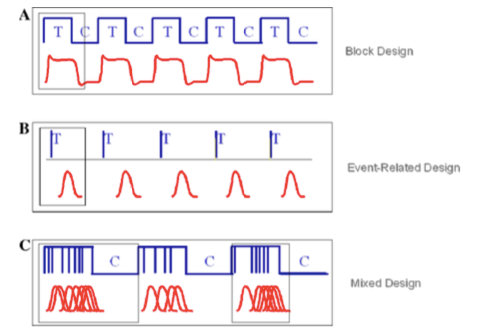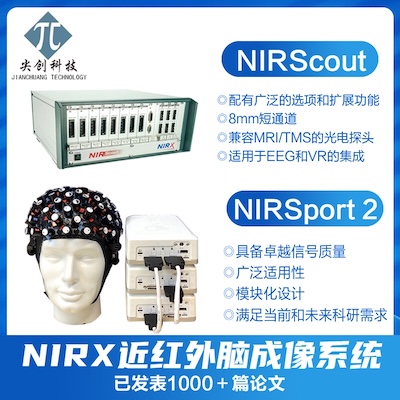This is a guest post by Ning Liu from Stanford University.
–
A basic block design includes two conditions: task condition and control condition. The two conditions present alternatively, thus is also called ‘AB block’ (Fig. 1A). This design assumes that the two conditions can be cognitively added, implying no interactions among the cognitive components of a task. A subtraction comparison strategy then can be used in the data analysis to assess the brain regions involved in the performance of the task. Although, in most cases, this assumption is invalid, many people still use it because it usually produces robust and reproducible results. A block design task often includes more than five epochs per condition, and each epoch lasts 10 to 30 seconds. As an example, we used the following block-designed emotional face task in one of our studies: R-F-S-F-S-F-S-F-S-F-S-F-S-R, where R, F and S represent rest, fearful face and scrambled face epochs respectively. Each task epoch (both F and S) lasts 20 s, and each rest epoch lasts 30 s. (Liu, et al. 2015)
Event-related design (Fig.1B) allows the order of conditions present randomly and the time intervals between stimuli vary. This design is more naturalistic and allows for detecting transient variations in hemodynamic responses (HRF). However, event-related design usually needs more number of stimuli in order to enhance the statistical power, and the experiments are often longer than blocked designs.
Mixed design (Fig. 1C) combines block and event-related designs. It alternates two conditions (task and control) as in a block design. Within a block, the interstimulus interval (ISI) varies as in an event-related design. It allows for extracting brain regions either exhibiting transient neural activity (item-related information processing) or sustained neural activity (task-related information processing). However, it involves more assumptions than other designs, and the estimation of the HRF is poorer than event-related design.

References:
Amaro E Jr, Barker GJ, “Study design in fMRI: basic principle”, Brain and Cognition, 2006, 60(3):220-32.
Liu N, Cui X, Bryant DM., Glover GH, Reiss AL, “Inferring deep-brain activity from cortical activity using functional near-infrared spectroscopy”, Biomedical Optics Express, 2015, 6(3): 1074-89. doi: 10.1364/BOE.6.001074.



Being new to fNIRS research I was wondering if it is possible to also use shorter rest epochs in a blocked design making the design more efficient? Most studies use a 30 s rest epoch and thereby make sure that the BOLD response has recovered before the next block begins. However, the classical model of the BOLD response is peaking around 6s after stimulus onset and after 15 s there is the negative undershoot with a rather small amplitude. Given the lower signal-to-noise ratio, I would assume that NIRS doesn’t capture this negative undershoot? Do you have experience with that or are aware of any literature investigating this?
Based on these assumptions it would be possible to reduce the time of the resting period to 15 s or even 10 s. I am happy about any comments on that.
The following is answered by Ning Liu:
If your goal is to study HRF with block design, then longer resting time is better. As your said, HRF usually needs 15-20s to back to initial level.
There are many publications regarding this topic. To list a few:
Franceschini, M.A., Fantini, S., Thompson, J.J., Culver, J.P., Boas, D.A., 2003. Hemodynamic evoked response of the sensorimotor cortex measured non-invasively with near-infrared optical imaging. Psychophysiology 40, 548–560.
Franceschini, M.A., Toronov, V., Filiaci, M., Gratton, E., Fanini, S., 2000. On-line optical imaging of the human brain with 160-ms temporal resolution. Opt. Express 6, 49–57.
Abtahi, M., Amiri, A.M., Byrd, D., Mankodiya, K., 2017. Hand Motion Detection in fNIRS Neuroimaging Data. Healthcare (Basel) 5(2):20.